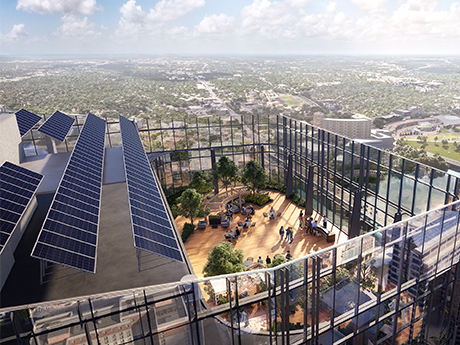Interviews by Taylor Williams
The office markets of the major Texas cities have always been birds of different feathers, built to accommodate drastically different types of users and disproportionately subject to broader swings in occupancy and rent growth.
Dallas-Fort Worth (DFW) remains the king of corporate relocations and regional consolidations, and the metroplex’s office market benefits from the highest degree of diversity among users, an attribute that has ushered it through the darkest days of the COVID-19 pandemic. Meanwhile, the Houston office market, hobbled for years by its reliance on energy users, may finally be poised to see some growth in occupancy as prices of these commodities head for the moon.
In Austin, the non-California tech capital of the country, the supply of office space is still playing catch-up to demand, as evidenced by the healthy rents these buildings have achieved during the state capital’s ascendance to major-market status. And San Antonio? Like most commercial asset classes in the Alamo City, the performance of the office sector is steady, offering neither the glamorous appeal of trophy buildings with marquee users that attract institutional investors nor the profound cyclical dips that scare them away.
Yet after two years of prolonged disruption to traditional work routines, these markets all share a common goal: maximizing the return of people back to their buildings. The willingness or reluctance that employees have to returning to their offices, on either full- or part-time bases, are factors of age, generational upbringing and personal workstyles. This ensures that there’s tremendous variability in these sentiments.
In addition, all office-using employers face the challenge of delicately walking the line between getting employees back in the building and making good use of their space versus alienating staffers that are dead-set on limiting or eliminating commutes and in-person interaction. There are no simple solutions to these dilemmas, and nobody knows for certain how they will play out.
In this piece, we explore these issue and others through the eyes of brokers. Through their roles as liaisons between tenants and landlords, as well as consumers of key office-usage data and arbiters of critical language in leases, brokers see and live these issues in real time. If perception is reality, then the insights of these individuals offer snatches of clarity on the potentially precarious future of this asset class.
Representative market participants contacted by Texas Real Estate Business included Sam Meginnis, vice president at Altschuler & Co. (Dallas); Josh Morrow, vice president at Avison Young (Houston); Bo Beacham, first vice president at CBRE (Austin); and Garrett Carlson, vice president at Stream Realty Partners (San Antonio).
What follows are their edited responses:
Texas Real Estate Business: What macroeconomic, demographic or health-related factors are influencing the volume and velocity of office leasing and absorption the most in your market?
Sam Meginnis: The health-related concerns around returning to the office have subsided for the most part. We are focused on unemployment, inflation, monetary policy and foreign conflict as the major forces at work right now.

Sam Meginnis, Altschuler & Co.
First, a tight labor market is forcing employers to gain an edge in recruitment by offering next-level office spaces/experiences to their employees. The flight to quality is strong. Inflation is here in the biggest way most of us have experienced in our professional lives, and it’s making urban living in larger markets more expensive for the workforce, especially for the middle and lower classes. Companies have to give more thought to where large portions of their workforces are located.
The Federal Reserve committing to increasing interest rates over the coming quarters, and potentially years, will also have interesting effects that have yet to be determined. Lastly, the Russian-Ukrainian war is causing shifts in the global economy and supply chain. A lot has yet to be played out, but none of these forces should be ignored, especially by the largest office users.
Josh Morrow: Factors including record-high inflation, rising interest rates and unrest in Europe all weigh on people’s minds as they contemplate plans for the future. Internally, companies are also having to manage a diverse age demographic and different drivers associated with those employees.
In attempts to attract and retain talent, we see companies taking a bit more time planning and doing their best to accommodate those drivers when it comes to long-term office space solutions. At the end of the day, companies recognize the need for office space, but we’re seeing more variation in what that looks like. Hybrid work schedules are a new reality. Identifying the right fit is what we’ve been helping our customers with on a consistent basis in the Houston market.
Bo Beacham: Austin has seen quite a bit of office leasing velocity over the past six to nine months. A lot of the leasing velocity has been driven by companies that are new to the market and setting up offices in the city. Austin remains a very attractive market due to the quality of life, cost of living benefits compared to coastal markets and the robust talent pool that exists here.
Garrett Carlson: San Antonio has a few factors that are impacting its return to strong office leasing. Many of our largest tenants operate non-customer-facing, back-office business units. These groups have largely switched to successful work-from-home strategies. With large numbers of jobs available, employers are not forcing employees to return to the office in fear of those employees finding a job that will continue to let them work from home.
Those who are looking to come back to the office are evaluating how often and how many employees will need space. This is allowing many companies to downsize footprints significantly and relocate their offices to nicer buildings. As San Antonio’s housing continues to develop toward in the Far North and Far Northwest submarkets, offices are moving in that direction as well. This is hurting the downtown office market but helping the suburban offices.

Pictured is a portion of the 15,000 square feet of retail and restaurant space at The Quad, a new office project under construction in Uptown Dallas by Stream Realty Partners. As companies work to bring people back to the workplace, the presence of these accompanying uses will also play important roles in the battle for occupancy among owners.
TREB: What types of users are leading the return to office buildings in your market, and what do these companies typically cite as the most important criteria/feature for successfully bringing their workforces back to the building?
Meginnis: Law firms seem to be leading the charge, but it’s hard to tell which companies are experiencing strong employee return to the office. Highly amenitized, Class A assets have the strongest occupancy rates. Buildings we visit regularly in the Dallas urban core are, at most, 30 to 40 percent occupied during the week. Occupancy rates at suburban assets in the Class A and B categories with fewer amenities are even lower. The winners are high-quality, conveniently located buildings with strong neighborhood amenities.

Josh Morrow, Avison Young
Morrow: A wide variety of users are leading the return, but we have seen visible growth in the engineering and construction industries. Many of our engineering clients are having trouble filling seats to meet workload demands. Criteria that drive returns to office include the need to attract and retain talent, train new employees, establish culture and comradery and facilitate communication and problem solving. It may come as no surprise, but Houston, as well as Dallas and Austin, have all seen a higher percentage of employees return to the office as compared to other major markets across the country.
Beacham: Several users have been back in the office since late 2021, particularly those that have mission-critical work or those that cannot operate remotely. Life sciences firms and R&D users have been in the office throughout the pandemic. Also, the more local and regional firms have been back in the office for past several quarters.
As of the end of the first quarter, we are starting to see Big Tech users bring their employees back to the office or give them the option to return. The primary reason companies are returning to the office is for productivity and to build company culture. While most companies have found success working from home, it remains tough to innovate and collaborate remotely.
Carlson: San Antonio’s construction, engineering and banking companies have been among the first to return to the office. These businesses have been expanding for the past two years and are now looking for more space. Many firms are exhibiting flights to quality. With hybrid models becoming more normal, companies are looking to upgrade their office spaces such that employees are excited to work and can be lured them away from their homes.
TREB: With regard to terms on new leases, what kind of flexibility are tenants in your market generally seeking?
Meginnis: Tenants are requiring a lot of flexibility on parking and the use of their spaces. We have seen multiple tenants plan and lease spaces with one workstation or parking space for every two to four employees. These users face uncertain return timelines for most of their employees and intend to have a more coordinated hybrid flow of employees to and from the office.
Morrow: These demands vary, as some companies are still hesitant to sign long-term leases because of a desire to maintain flexibility and because they lack clarity on the future business environment. There was a feeling that we were finally getting over COVID-19 and returning to normal when we were hit with a slew of curveballs — inflation, rising interest rates, the war in Ukraine. That said, market conditions are very tenant-friendly right now, and many users can capitalize by locking in long-term leases that also incorporate flexibility through expansion, contraction and termination options.

Bo Beacham, CBRE
Beacham: Not much has changed as far as lease terms for new deals over past year. Austin remains a landlord’s market, particularly in the most desirable submarkets, so flexibility requested by tenants has not necessarily been afforded. For new construction, we have seen tenant improvement (TI) concessions increase, but the rates continue to escalate, so landlords have largely been able to absorb the increases in TI.
Carlson: With still a lot of uncertainty on how many employees will ultimately return to the office, tenants are seeking shorter-term leases and/or expansion/contraction rights as part of their leases. Tenants have been cautious about getting locked into longer-term leases without having the ability to shift paths if more — or less — space is needed.
TREB: How would you describe the movement in rental rates for office properties in your market over the past two years, and how much of a discrepancy exists between demand/absorption/rent growth between the Class A and Class B sectors?
Meginnis: The very best properties continue to recognize strong rent growth. Lower-end Class A product seems to be struggling coming out of the pandemic and with new economic conditions. Class B office product seems to have flatlined, while back-office operations struggle to bring their remote workforces back.
Morrow: We have been seeing a slight decline in rates, especially for Class B assets. However, landlords have tried to preserve rates to maintain asset value by offering large concession packages. As a result, we’ve seen a flight to quality, which sheds some concern for the future of Class B assets, as there’s a large discrepancy in demand/absorption between Class A and B buildings.
Beacham: We are definitely seeing a flight to quality as tenants are trying to provide an environment for their employees that excites them to get back into the office. There’s a focus on health and wellness that older, Class B projects cannot easily deliver.
According to CBRE’s research, in 2021, Class A product registered over 892,000 square feet of positive net absorption, while Class B product experienced more than 571,000 square feet of negative net absorption. In the fourth quarter of 2021, full-service gross (FSG) rents for Class A space grew by 35 cents quarter-over-quarter to $49.02 per square foot. On the flip side, Class B rates decreased by 18 cents to $35.43 per square foot. However, marketwide rental rates for all classes have grown by $3.77 over the last two years to $42.66 per square foot, as of the fourth quarter of last year.
Carlson: The average Class A rental rates at the end of the fourth quarter of 2021 was $34.53 per square foot, up from $32.99 per square foot in the first quarter of 2020. Class B rates are just slightly higher at $24.17 per square foot compared to $23.64 per foot during that stretch. Out of approximately 4.5 million square feet of currently available product, just under half of that is Class A space and the remainder is Class B.

Garrett Carlson, Stream Realty Partners
Most of the rise in Class A rents comes from new developments coming on line. However, tenants for these new buildings are already in San Antonio and are moving out of legacy buildings. As a result, Class B landlords are lowering their rates to stay competitive. The trend of tenants looking for smaller, nice spaces should continue, and Class A product will have the most activity moving forward.
TREB: Can you provide a brief rundown of the supply/demand balance and performance of office subleasing activity in your market?
Meginnis: Larger, high-quality, move-in-ready subleases seem to be moving at reasonable savings to tenants. As for the rest, the combination of ample supply and lackluster demand equals a negligible performance.
Morrow: A healthy amount of sublease space still remains in Houston, although the numbers aren’t as high as they were at the peak of the sublease glut several years ago. The main reason for the decline in sublease space is due to sublease term burn off and conversion to direct vacancy rather than absorption of those subleases. We’ve also seen a slight uptick in sublease availability between the fourth quarter of last year and the first quarter of this year.
Beacham: Most of the quality subleases throughout the Austin area have been leased or re-absorbed. A lot of the sublease activity has been due to new-to-market tenants that were looking for immediate occupancy and less commitment than inking new, long-term deals on direct space. We are back to pre-pandemic sublease metrics.
Our research shows that available sublease space continued to contract in the fourth quarter of 2021, falling more than 200,000 square feet on a quarter-over-quarter basis. This movement was driven both by leases signed and space withdrawn from the market during the quarter.
Carlson: At the end of the fourth quarter of 2021, we were tracking 11 subleases with available blocks of 25,000 square feet of more in San Antonio. This does not include an additional 500,000 square feet of sublease space recently put on the market in the Central Business District. With more large direct blocks of space on the market available than ever before, the absorption of the sublease blocks should be a long, slow process.
— This article originally appeared in the April 2022 issue of Texas Real Estate Business magazine.


